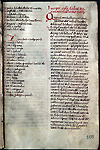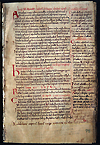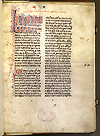Diffusion
Collections of Arabic and Greek texts, along with new teaching methods, attracted students from all over Europe to Italy. Once graduated, doctors returned to their home with texts they had studied, and teaching methods they had learned. From Oxford, England in the 13th century to Germany in the 15th, this heritage was assimilated in different ways.
Medical Works at Oxford
The core texts of Salernitan teaching that students brought back to Oxford reflected the cultural diversity of southern Italy. They included classical Greek treatises, introductions to medicine, Byzantine diagnostic booklets, as well as later additions to these major reference works. The following pages from Manuscript 8 of the National Library of Medicine's collection show the diversity of texts included in one book.

Substitution was a pharmaceutical procedure that allowed a doctor to substitute a drug that they lacked with another with similar therapeutic effects.
Manuscript E 8, f. 168 recto

The author of this therapeutic collection has been identified (without conclusive proof) as the Byzantine physician Alexander of Tralles (525–605).
Manuscript E 8, f. 78 recto
![Pseudo-Galen, De phlebotomia (On the section of veins [to bleed patients]). Galen was credited with many treatises on the topic. Manuscript E 8, f. 132 verso. F. 132 verso from Manuscript E 8. De phlebotomia (On the section of veins [to bleed patients]), credited to Galen. A hand written manuscript page, the beginning letter of both paragraphs is a calligraphy letter written in red ink.](images/MS_08_132_versot.jpg)
Bleeding, which was thought to evacuate pathological matter, was a common method of therapy in antiquity and the Middle Ages. Galen was credited with many treatises on the topic.
Manuscript E 8, f. 132 verso.
Natural History at Oxford
Oxford teaching integrated the Salernitan medical material with texts by Aristotle. Besides philosophical treatises, Aristotle had written works about natural history, which were called historiai and were collections of data resulting from previous research. Scholars submitted this data to critical analysis, and served as a basis for further work.

Aristotle's most important natural history treatise was the Historia animalium (Research on animals), shown here in Latin translation.
Manuscript E 3, f. title.
A Method of Teaching
The Oxford teaching method was based on careful scrutiny of texts aimed at distinguishing from one another all cases discussed in the works under analysis. As a result, textual data was organized so as to form hierarchical trees formalized in books, according to an analytical method perhaps rooted in the Arabic tradition.
![Master Ri[chard], Distinctiones super iohannicium (Distinctions on Johannitius [that is, on the Articella]). The Master Ri[chard] to whom this work is attributed has been uncertainly identified as Richard Anglicus (or: de Wendover) (d. 1252 A.D.). Manuscript E 78, f. 99 recto. F. 99 recto from Manuscript E 78. Distinctiones super iohannicium (Distinctions on Johannitius [that is, on the Articella]). A hand written manuscript featuring tabular presentation of the points to be discussed in expounding the Articella.](images/NLM52t.jpg)
The Master Ri[chard] to whom this work is attributed has been uncertainly identified as Richard Anglicus (or: de Wendover) (d. 1252 A.D.).
Manuscript E 78, f. 99 recto.
Germany
In Germany, texts of different origins were grouped. The gynecological booklet ascribed to Cleopatra appeared together with works by such Arabic scientists as Mesue, Albucasis, and Rhazes, and with a more recent treatise by the Italian Marsilio de Santa Sofia (d. 1405), as well as with contemporary anonymous tracts on plague and leprosy, and a lexicon of plant names.
![Anonymous, Synonima [herbarum] (Plant names). This lexicon contains Latin phytonyms with their German translation. This suggests that learned medicine was integrated into the daily practice of German-speaking doctors. Manuscript E 33, f. 35 recto. F. 35 recto from Manuscript E 33, Syonima [herbarum] (Plant names). A hand written two column lexicon.](images/NLM1t.jpg)
This lexicon contains Latin phytonyms with their German translation. This suggests that learned medicine was integrated into the daily practice of German-speaking doctors.
Manuscript E 33, f. 35 recto.
Last Reviewed: May 2, 2012


